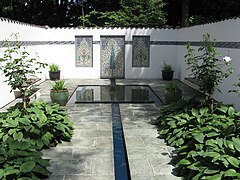Marie Balian
Marie Balian (Née Alexanian) (January 25, 1925, Marseille, France – September 13, 2017, East Jerusalem) was an Armenian artist and ceramic painter, especially known for her distinct and impressive ceramic tile murals.
Her family originally came from the small Turkish town Kutahya. They fled Turkey on foot to Greece in 1917. From there, they took ship for France. Marie grew up in Lyon, France. As a six-year-old girl she began drawing and at ten she was doing portraits.[1] She studied at the École nationale supérieure des Beaux-Arts in Lyon[2] but had to drop out for financial reasons. In 1953 she met her distant cousin Setrak on his way to study ceramic technology with Ray Finch and Bernard Leach in England. They married in 1954 in Betlehem.
Her contribution to Middle Eastern art was to introduce more Armenian elements -by adding trees, animals and birds in a primitive style-to renovate art, and elevate the craft to fine art and therewith brought her own cachet. She added movement to what had traditionally been static compositions and reminded us of the glorious beauty of nature. Suddenly, gazelles were prancing, peacocks were preening, garlands were flowing. The concept known as the Gardens and Views of Paradise of Marie Balian developed. She referred to 13th century after Christ when Persian artists were favoring garden scenes for their painted ceramic tiles. Symmetry gave way to dynamic asymmetry. At a later age she herself becomes aware she is a link in an ancient chain, and that she has played a crucial role in rescuing one branch of a centuries-old tradition from oblivion. "It's very easy for me. It's as if I had already done this in an earlier age, like the fourth, fifth or sixth century." She became the master painter of the Balian atelier[3] in East-Jerusalem, the Palestinian Pottery and a renowned artist.[4]
In the introduction of the award-winning documentary "The Glimps of Paradise" about her life and art and worldwide recognition Marie is described as one of the icons of the Jerusalem art world.[5] The book "Birds of Paradise" further documents her fine art.[6] Modern media like Google Images and Pinterest show a variety of her work.
Balian Family

In the 1600s, Armenian artisans in a small Turkish town named Kutahya developed a distinctive "Islamic" style in decorative ceramics, while also developing a series of unique and instantly recognizable local styles including playful figures, ceramic eggs, coffee cups, rosewater jars and various types of votive ware. In late 1918, the British authorities invited David Ohannessian (commons), a renowned ceramicist who had established a workshop in Kutahya in 1907 and had developed an international clientele there, but had been deported to Aleppo in 1916, to travel to Jerusalem to consult on the planned British renovation of the tiling of the Dome of the Rock. After some experiments with the existing 19th century kiln and local materials, Ohannessian returned to Kutahya to obtain the needed clays and other minerals and recruit the remaining Armenian ceramicists to join him in Jerusalem. Ohannessian brought 8-10 Kutahya artisans to Jerusalem in 1919, including the expert wheel potter Nishan Balian, and the accomplished painter Mgrditch Karakashian. Balian and Karakashian worked for Ohannessian until 1922, when they struck out on their own, opening a second Armenian ceramics atelier in Jerusalem, located on Nablus Road. In 1966 the Balian and Karakashian families split their businesses and established separate workshops. The Balian atelier was known as the Palestinian Pottery and Marie was the master painter. Neshan, Marie's son feels compelled to continue the family tradition. He studied ceramic engineering in the United States[7]
Fame and recognition
Marie Balian came to world attention in 1992 when the Smithsonian Institution, the national museum of the United States, paid tribute to her work with a six-month show. The exhibition "Views of Paradise" included more than 20 wall-size panels that together presented the artist's conception of the ultimate garden. The exhibition was so well-received that the gallery extended its stay[8] Further exhibitions followed in Boston MA (ALMA Museum), Israel (Eretz Israel Museum) and Alicante, Spain. Balian's work is shown on a stamp[9] and many publications followed[10][11][12][13][14] Balian's work is widely spread on the internet, and in museums such as the Victoria & Albert Museum in London, England[15]
Works from the "Views of Paradise" exhibition were installed in the Persian Garden in Wassenaar, The Netherlands.
Gallery
-
Glimpse of Paradise (2004), Jerusalem
-
Persian Garden
-
Persian Garden
-
Persian Garden
-
Persian Garden
Notes
- ^ "Saudi Aramco World: The Gardens of Marie Balian". archive.aramcoworld.com. Retrieved 2018-10-31.
- ^ "Ecole nationale supérieure des beaux-arts de Lyon – Accueil". www.ensba-lyon.fr (in French). Retrieved 2018-10-31.
- ^ "The Tile Art of Marie Balian & Balian Ceramic Tiles of Jerusalem". Armenian Ceramics. Retrieved 2018-10-31.
- ^ "Saudi Aramco World: The Gardens of Marie Balian". archive.aramcoworld.com. Retrieved 2018-10-31.
- ^ Katzir, Yael, A Glimpse of Paradise – Marie Balian: Armenian Artist in Jerusalem, New Love Films, retrieved 2018-10-31
- ^ "Birds of Paradise. Marie Balian and the Armenian Ceramics of Jerusalem | Kenaan-Kedar, Nurith". www.bookdealers.co.za. Retrieved 2018-10-31.
- ^ "Saudi Aramco World: The Gardens of Marie Balian". archive.aramcoworld.com. Retrieved 2018-10-31.
- ^ "Saudi Aramco World: The Gardens of Marie Balian". archive.aramcoworld.com. Retrieved 2018-10-31.
- ^ "WNS: IL037.03 (Armenian Ceramics in Jerusalem – Marie Balian 'Tree of Life')". www.wnsstamps.post. Retrieved 2018-10-31.
- ^ "Birds of Paradise. Marie Balian and the Armenian Ceramics of Jerusalem | Kenaan-Kedar, Nurith". www.bookdealers.co.za. Retrieved 2018-10-31.
- ^ "Fabulous mural by Armenian artist Marie Balian one of Jerusalem's hidden gems". Public Radio of Armenia. 2015-06-11. Retrieved 2018-10-31.
- ^ "Water jug | Balian, Setrag | V&A Search the Collections". collections.vam.ac.uk. Retrieved 2018-10-31.
- ^ "The Tree of Life – Kalbian Hagerty LLP". Kalbian Hagerty LLP. Retrieved 2018-10-31.
- ^ "Interpreting Ceramics : issue 4". interpretingceramics.com. Retrieved 2018-10-31.
- ^ "Water jug | Balian, Setrag | V&A Search the Collections". collections.vam.ac.uk. Retrieved 2018-10-31.





